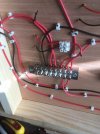jonte
Western Thunderer
I started out with the best of intentions, collecting together a variety of parts including a piano hinge and catch to make a drop down top for ease of access, together with an offcut of aluminium to top it off, according it the air of an exhibition layout in the process.
Then I remembered my new found mission statement of ‘just get on with it’. So I did, and what followed was a complete change of tack.
An abyss size hole was cut through the surface of the board to allow a host of wires, enabling suitable control of signals, points and whatnot, to break free form the depths below, topped off with some triangular shaped offcuts (with an open back to assist in the threading through of switches in the fascia) which will serve as a panel:



Okay, not what was intended as outlined, but it’s done and I can now move forward to the wiring up and - hopefully - making it all work.
Cheers for now.
jonte
Then I remembered my new found mission statement of ‘just get on with it’. So I did, and what followed was a complete change of tack.
An abyss size hole was cut through the surface of the board to allow a host of wires, enabling suitable control of signals, points and whatnot, to break free form the depths below, topped off with some triangular shaped offcuts (with an open back to assist in the threading through of switches in the fascia) which will serve as a panel:



Okay, not what was intended as outlined, but it’s done and I can now move forward to the wiring up and - hopefully - making it all work.
Cheers for now.
jonte


 ).
). .
.
 I’d already realised I’d forgotten to add clips to my order at Toolfix the other day, now it looked like another postal purchase was required for switches too…..and with a pending strike by our friendly posture to contend with
I’d already realised I’d forgotten to add clips to my order at Toolfix the other day, now it looked like another postal purchase was required for switches too…..and with a pending strike by our friendly posture to contend with  …..Recalling I’d seen some switches somewhere, I spent most of the afternoon trawling; you know how it goes. Luckily I discovered a half used box of them containing three, to go with two others I’d found amongst the bits and bobs that are ‘stored’all over the place,thus I was back in business.
…..Recalling I’d seen some switches somewhere, I spent most of the afternoon trawling; you know how it goes. Luckily I discovered a half used box of them containing three, to go with two others I’d found amongst the bits and bobs that are ‘stored’all over the place,thus I was back in business.



 In between the two pairs of sockets as described, will go a single socket for a 12V DC power supply, intended for my signals. To the very top will go a couple more on/off switches, this time to operate the (hopefully) bouncing semaphores.
In between the two pairs of sockets as described, will go a single socket for a 12V DC power supply, intended for my signals. To the very top will go a couple more on/off switches, this time to operate the (hopefully) bouncing semaphores.










 ); that said, when everything came to a sudden halt on the middle road siding, I guessed right that I’d forgotten to connect up a feed…….. easy to lose track with all that knitting.
); that said, when everything came to a sudden halt on the middle road siding, I guessed right that I’d forgotten to connect up a feed…….. easy to lose track with all that knitting.



